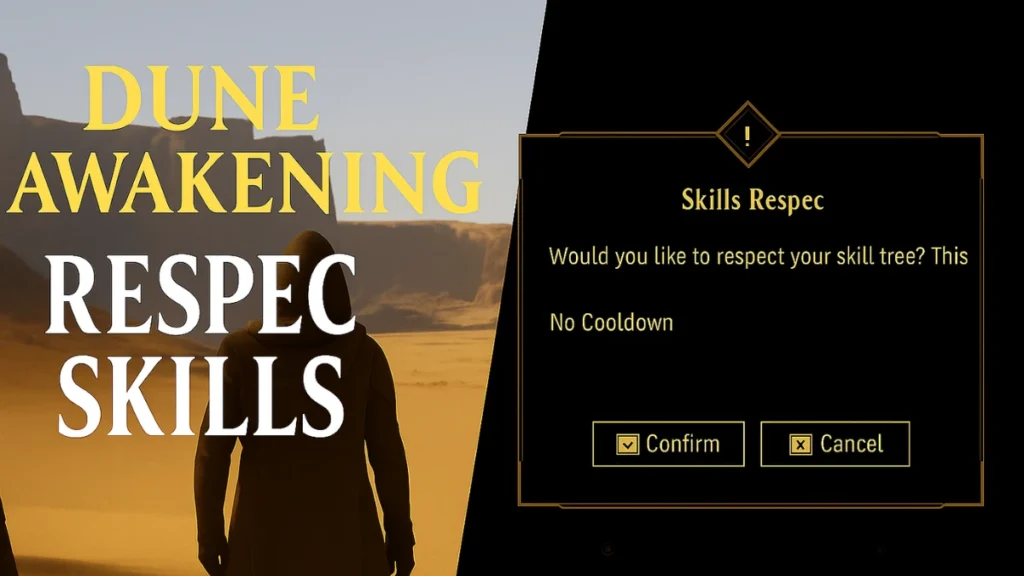In Dune: Awakening, developing your character is a central part of gameplay, offering players flexibility to tailor builds across multiple class skill trees. As you gain experience and explore different playstyles, you might find yourself wanting to undo past choices and try a new strategy. The game supports this adaptive approach through a respec system that lets you refund and reallocate your skill points—though not without a few important limitations.

This guide covers everything you need to know about respeccing skills in Dune: Awakening, including how it works, what you can and cannot change, and how to make the most of the system.
How Classes and Skills Work in Dune Awakening
Dune: Awakening does not follow the rigid class structures seen in many MMOs. Instead, players begin with a primary class—such as Mentat, Trooper, Swordmaster, or Bene Gesserit—which grants access to its corresponding skill tree and a unique starting ability. However, you’re not locked to that tree alone.
Nex Playground 12-Month Play Pass [Digital Code]
By finding and completing quests for class trainers scattered across Arrakis, you can unlock additional class trees, gaining access to their skills and passives. This hybrid system lets you mix and match talents to suit your evolving playstyle.
That said, your original class choice remains permanent. You cannot change your primary class or its starting ability, even through respec.
How Respec Works in Dune: Awakening
Respeccing in Dune: Awakening is a built-in mechanic designed to encourage experimentation. If you’re unsatisfied with your current build or want to try something new, the process to respec is straightforward and free of cost.
To perform a respec:
- Open the Skills Menu (press
Kor access it via the system menu). - Navigate to the bottom right corner and select Respec Skill Tree.
- Confirm the action by pressing
Spaceor selecting “Confirm” on screen. - For controller users, this action is typically mapped to the D-Pad Down; for PC players, pressing
Rinitiates the respec.
All spent skill points are immediately refunded, allowing you to redistribute them as desired—provided you still follow prerequisite unlocking orders within the trees.
Respec Cooldown and Limitations
While the act of respeccing is simple, the system does enforce a key limitation: a cooldown period of 48 real-world hours between respecs. This means once you reset your skills, you must wait two full days before doing it again.
The cooldown is designed to prevent constant swapping and to encourage more thoughtful decision-making. Therefore, each respec carries strategic weight—especially at higher levels when point distribution significantly impacts your combat effectiveness and role.
Moreover, even after a respec:
- Your primary class and its unique starting skill remain unchanged. This is a permanent choice made at character creation.
- You must still unlock prerequisite skills within a tree before accessing higher-tier talents.
- Only three Abilities and three Techniques can be equipped at once, though passives can be unlocked more freely.
Skill Points and Build Planning
Players receive 200 total skill points throughout their progression. While this is a generous amount, it’s not enough to max out all available skills across all trees. In fact, some skills require multiple points to level, further increasing the need for strategic allocation.
Given this limitation, the respec system plays an essential role in long-term build planning. Hybrid builds—where you pull core strengths from multiple class trees—are popular and effective, but they require you to commit points with care.
Before respeccing, it’s wise to consider:
- Which trainers you’ve unlocked: Unlocking all class trainers gives you the full spectrum of options to build around.
- Your current gameplay needs: PvP, exploration, or farming may each favor different skill combinations.
- Which abilities you actively use: Since only three can be equipped at a time, spreading points too thin may weaken your build.
When and Why to Respec
There’s no universally “right” time to respec, but certain moments may naturally call for it:
- You’ve unlocked a new trainer and want to incorporate a newly available class into your build.
- Your current playstyle feels ineffective or stale.
- You’re preparing for a different type of content—e.g., PvP battles, resource farming, or boss fights.
- You’ve gained enough levels to support a more specialized build.
Respeccing is especially valuable in the early and mid-game stages, when you’re still discovering which classes and skills suit you best. In the late game, it becomes more about fine-tuning and adapting to situational demands.
Final Thoughts
Dune: Awakening’s respec system is a thoughtfully designed feature that provides both flexibility and structure. By allowing full skill point refunds with no cost but enforcing a 48-hour cooldown and locking the starting class, the game encourages meaningful experimentation without trivializing build choices.
Whether you’re a new player navigating early content or a seasoned explorer looking to optimize for endgame scenarios, learning how and when to respec is a vital part of mastering your journey across Arrakis. Consider each reset as an opportunity to adapt, evolve, and reshape your approach, one decision at a time.
Read More:
How to Get the Shadow Mantle and Beat Roaring Knight in Deltarune Chapter 3
Deltarune Egg Room Guide: How to Find All Hidden Eggs by Chapter
Sonic Saves Robloxia Guide: How to Beat All Levels, Unlock Secrets, and Complete 6 Runs
Deltarune: How to Find and Use Mike’s Room Code in Chapter 4
Crystal of Atlan Guide: Best Classes, Builds, Leveling & Combat Tips
More Gaming Guides
- 01FC 26 Frostbite Finisher Evolution Best Players – Top Strikers to Upgrade
- 02Where to Find Advanced Electrical Components in ARC Raiders
- 03All Wishblossom Ranch Recipes in Disney Dreamlight Valley
- 04How to Find Tomo’s Lost Cat in The Forge – Complete Quest Walkthrough
- 05Diablo 4 Goblin Event Rewards and Loot Guide
- 0610 Best Minecraft Pocket Edition Seeds to Try Right Now
- 07Arknights Endfield Release Date, Platforms, Gameplay, and What to Expect
![Nex Playground 12-Month Play Pass [Digital Code]](https://m.media-amazon.com/images/I/71kgUMvdvaL._SL1500_.jpg)

